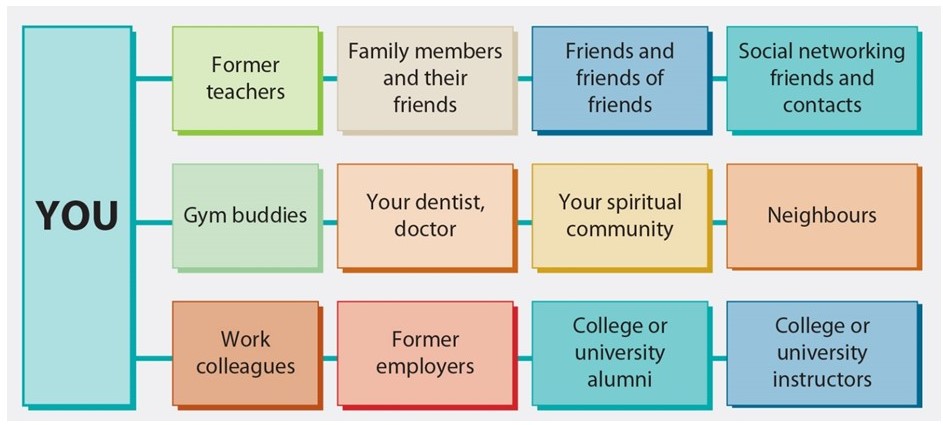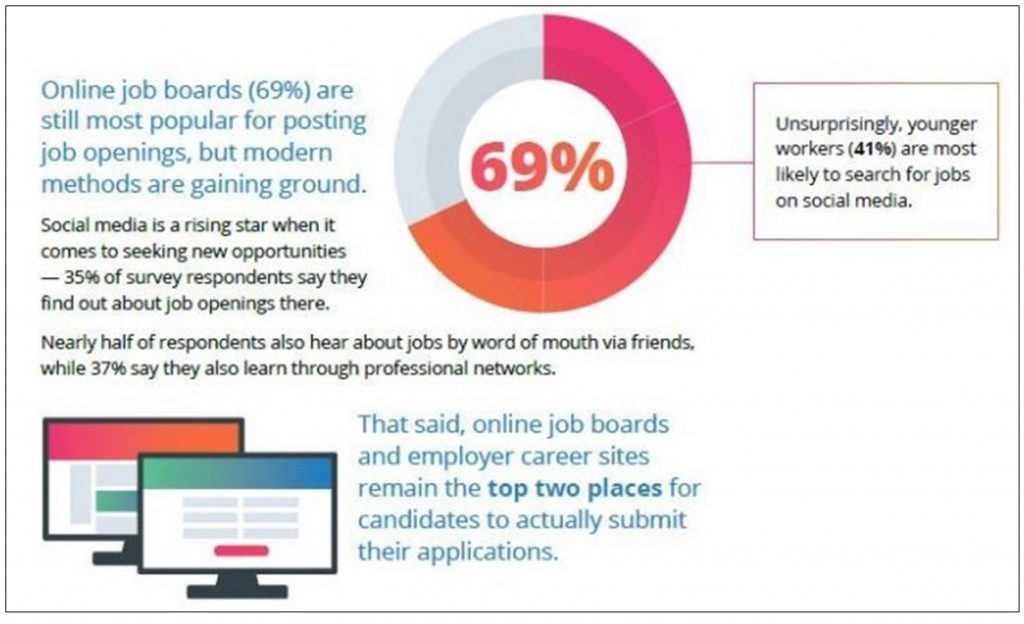10.1 Finding a Job
Job Search Strategies
If you devote a portion of your life to training for a career, nothing is more important at the end of that program than getting a job where you can apply your training and launch your career. The job application process poses a challenge that requires a skill set quite different from that which your core program courses teach you, yet you cannot get a job without this skill set. In most professions, the competition for jobs is so fierce that only your communication A-game can help you through the hiring process. This chapter focuses on key behaviors and actions that will help you to find a job that best fits your interests, knowledge, and skills.
To get started, take a look at this video by the BI Norwegian Business School (2017) on the job search process: The Job Hunting Process
Networking
A recent study showed that approximately 61% of job seekers either used their personal network and/or online social network to land their dream job (Business Communications, 2019). What exactly is a personal network and why is it so effective? A network is a group of people with whom you have a personal relationship based on similar interests. As you build this network and cultivate the relationships, you develop a connection and, most importantly, trust with the people in your network. These relationships become useful because the majority of the job market is hidden; that is, some jobs are not advertised through conventional means. Most jobs are often found through referrals and word of mouth; thus, having a network of people that can give you inside information about available jobs in your field is invaluable. In addition to the inside information, people in your network may also serve as personal references and a bridge between your potential employer and you. Some tips to help you develop a personal network include:
- Develop a list of people to speak with about your job search
- Contact the people on your list
- Call and possibly arrange a meeting with any referrals provided by your contact list
- Join an online networking group
- Conduct research on additional networking tips and trends
Figure 10.1.1 displays the various types of networks that exist in your life. As you can see, you can draw upon many types of contacts when you are seeking employment.
Figure 10.1.1 A matrix template to help develop a personal network. (Business Communication, 2019)
Networking involves building relationships over time. This applies not only to personal networks, but also online networks. An online social network is somewhat different than a personal network. Though you may have hundreds of contacts or followers in your social network, the degree to which you know each other will be limited by how deep a relationship you have developed with them. You will most likely not know most of your followers, be they on LinkedIn, Instagram, Snapchat, Twitter, and Facebook; however, when thinking strategically about your career goals, you can develop professional profiles and cultivate your relationships with key followers over time. Start now, and read more about this topic in the chapter, The Online Application Process.
Online Job Sites
According to a recent Jobvite survey and as depicted in Figure 10.1.2, job boards continue to be the number one medium to access job opportunities (Morgan, 2019). While you could begin your job search by using major job search engines like Monster and Indeed, you should also narrow your search by consulting a wide range of platforms, including technology job boards, where job advertisements are posted. Here are a few resources to get you started:
- Job boards: Browse sites like Indeed, CareerBuilder, Glassdoor and Monster to search for jobs in your field.
- Specialty technology job lists: Look for job boards in technology, such as Tech Talent Canada, Work in Tech, itjobs.ca, techjobs.ca
- Company, organization and government websites: Visit the employment section on websites of companies you admire; search federal, provincial, and city websites for job government job postings.
- Seneca College student employment site: Visit the Seneca Works website for employment opportunities. You should also visit the placement office/career center and attend job fairs hosted at Seneca.
The following are sites are also worth searching for job postings and other information they offer on the job market:
|
Figure 10.1.2 A recent survey confirms that job boards continue to be the number one job search tool (Morgan, 2019). |
Many job seekers also use craigslist to look for work; just be aware that craigslist postings often lack detail and may come from headhunters or placement agencies, rather than from the direct employer.
Once you have found a job, make sure to print and/or save a copy of the job posting or job description. You will use this document to help you tailor your application materials. Because companies often delete the job posting once they have received sufficient applicants, it is important that you save your own copy of the document by copying the text and pasting it into a new document, or by saving the webpage.
Knowledge Check
Industry Associations, Conferences, and Job Fairs
Joining a professional association and attending its meetings and conferences will give you ample opportunities to network with employers and their recruiting agents. You should consider joining a professional association while you are a student so as to benefit from student membership and conference rates. Networking during association meetings and participating in committees will help you to establish your reputation as a professional and meet potential employers in the process. As in the previous scenarios, this only works if you are friendly and outgoing.
Conference participants who merely soak in others’ presentations and discussions without networking are effectively invisible to the recruiters. Make the effort to deliver in student presentation sessions or even participate on the conference organizing committee, whether paid or as a volunteer. The key is seizing the opportunities to meet professionals in your field.
You should also attend career fairs and sign up for interviews with visiting recruiters. Because colleges are a great resource for the emerging labour pool, they have tight connections with industry partners. When company recruiters come to your college, be there to ask them about their employment opportunities. Recruiters aren’t interested in students who aren’t interested in them, so do your homework and arrive prepared to ask intelligent questions and make a good impression. Attending career fairs and talking to recruiters is a great way of showing interest in a company and opening doors to further conversations.
You can do all this before you graduate. Imagine how many contacts you can accumulate over a three-to-four year program. By the time you graduate, you would have many people in your network who could possibly give you leads on job openings in your career field.
For your convenience, listed below are industry associations you can explore:
Air Transport Association of Canada (ATAC)
Canada’s Association of Information Technology (IT) Professionals (CIPS)
Canadian Association of Pharmacy Technicians (CAPT)
Canadian Society of Civil Engineering (CSCE)
Canadian Fire Safety Association (CFSA)
CWB Group (Welders Association)
Ontario Association of Certified Engineering Technicians and Technologists (OACETT)
Knowledge Check
Personal Branding
What is a personal brand and how do you develop one? A personal brand is a representation of yourself that highlights what you offer in terms of skills, knowledge, interests, and accomplishments. Begin developing your personal brand by asking yourself the following questions:
- What about yourself do you want to emphasize in the job search process?
- What qualities distinguish you from everyone else?
- What unique skills can you offer your employer?
- What makes you a sought-after employee?
- How will you make your future workplace better?
Use this information to promote yourself in online and offline forums. Online, create a Facebook page and a LinkedIn profile. Offline, create business cards and write an elevator pitch to introduce yourself at industry conferences, professional association events, and job fairs. No one will do a better job at promoting you than you will. For your information, here is a TEDx talk that explains personal branding further: Designing a Personal Brand From Zero to Infinity (2017).
Figure 10.1.3 explains the four steps involved in developing a personal brand for graduates.
Figure 10.1.3 The four steps in the personal branding process are explained (Business Communication, 2019).
EXERCISES 10.1.1
- Begin developing your network. Conduct at least one referral interview or join one online networking group. Record the results you experienced and the information you learned from the networking options you chose.
- Use several of the job search engines listed above to collect five job postings that you would be interested in applying to if they were available upon graduation. If you can’t find any in your local region, look further afield in neighbouring cities or even other provinces or countries you’d be interested in moving to. Compare the various postings. Identify common terms used in the lists of required skills and job duties. What are the common work experience and educational qualifications identified as required as assets?
Please note: Content for this section of the text has been partially adapted from Tom Bartsiokas’ and Tricia Hylton’s Communicating@Work (2019), which has been adapted from Jordan Smith’s original Business Communication for Success (2015). Some content has been adapted from a chapter on preparing to apply for work by Megan Savage, in Technical Writing (n.d.).
References
Bartsiokas, T. & Hylton, T. (2019). Communication@Work. CC by 4.0 https://pressbooks.senecacollege.ca/buscomm/ Adapted from Smith, J. (2015) Communicating for success. OER CC by 4.0.
BI Norwegian Business School. (2017). The job hunting process [Video]. Youtube. https://www.youtube.com/watch?v=WRC7y8VriuM
Guffey, M., Loewry, D., & Griffin, E. (2019). Business communication: Process and product (6th ed.). Toronto, ON: Nelson Education. http://www.cengage.com/cgi-wadsworth/course_products_wp.pl?fid=M20b&product_isbn_issn=9780176531393&template=NELSON
Morgan, H. (2019). A candidate’s job market means stronger competition for job seekers. The savvy intern. https://www.youtern.com/thesavvyintern/index.php/2019/05/20/stronger-competition-job-seekers/
Savage, M. (n.d.) Chapter 12.1: Preparation. In Gross, G., Hamlin, A., Merck, B., Rubio, C., Naas, J., Savage, M., & DeSilva, M. Technical writing. OER. CC by 4.0. https://openoregon.pressbooks.pub/technicalwriting/chapter/y-1-preparation/
TEDx Talks. (2017). Designing a personal brand from zero to infinity [Video]. Youtube. https://www.youtube.com/watch?v=Alqt7pIbp_o




